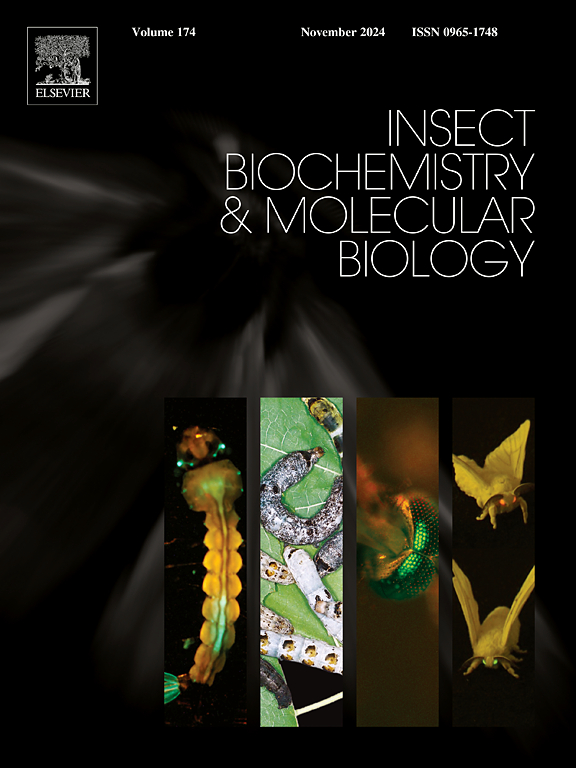Killing of Anopheles stephensi mosquitoes by selective triketone inhibitors of 4-hydroxyphenylpyruvate dioxygenase depends on a high protein meal
IF 3.7
2区 农林科学
Q2 BIOCHEMISTRY & MOLECULAR BIOLOGY
引用次数: 0
Abstract
The malaria vector Anopheles stephensi has expanded from Asia into Eastern Africa, posing a growing global health threat due to its adaptive biology and increasing resistance to conventional control methods. Here, we characterise 4-hydroxyphenylpyruvate dioxygenase (HPPD), a crucial enzyme in the tyrosine degradation pathway, and demonstrate its potential as a novel drug target in An. stephensi. Homology modeling combined with molecular dynamics simulations confirmed that key inhibitor-binding residues are highly conserved across mosquito HPPDs and predicted potent inhibition by triketone-based compounds. Using cell-based assay with codon-optimized recombinant expression in Escherichia coli, we screened several triketone and diketonitrile HPPD inhibitors and identified nitisinone as the most potent inhibitor, displaying nanomolar-range IC50 values. Membrane feeding assays showed that nitisinone's insecticidal activity relies on ingestion of a high-protein meal, with haemoglobin identified as the potent dietary factor driving toxicity. These results highlight HPPD inhibition as a promising blood-meal-dependent vector control strategy specifically targeting haematophagous mosquitoes.

选择性4-羟基苯基丙酮酸三酮双加氧酶抑制剂杀灭斯氏按蚊依赖于高蛋白餐。
疟疾病媒斯氏按蚊已从亚洲扩展到东非,由于其适应性生物学和对常规控制方法的抵抗力日益增强,对全球健康构成日益严重的威胁。在这里,我们描述了4-羟基苯基丙酮酸双加氧酶(HPPD),酪氨酸降解途径中的一个关键酶,并证明了它作为一种新的药物靶点在斯蒂芬按蚊中的潜力。同源性模型结合分子动力学模拟证实了关键抑制剂结合残基在蚊子HPPDs中高度保守,并预测了三酮类化合物的强抑制作用。利用基于细胞的密码子优化重组表达法,我们在大肠杆菌中筛选了几种三酮和二酮腈HPPD抑制剂,并鉴定了nitisinone是最有效的抑制剂,显示出纳米级的IC50值。膜饲养试验表明,尼替西酮的杀虫活性依赖于摄入高蛋白膳食,血红蛋白被确定为驱动毒性的有效膳食因素。这些结果强调了HPPD抑制是一种有前途的血食性媒介控制策略,特别是针对吸血蚊子。
本文章由计算机程序翻译,如有差异,请以英文原文为准。
求助全文
约1分钟内获得全文
求助全文
来源期刊
CiteScore
7.40
自引率
5.30%
发文量
105
审稿时长
40 days
期刊介绍:
This international journal publishes original contributions and mini-reviews in the fields of insect biochemistry and insect molecular biology. Main areas of interest are neurochemistry, hormone and pheromone biochemistry, enzymes and metabolism, hormone action and gene regulation, gene characterization and structure, pharmacology, immunology and cell and tissue culture. Papers on the biochemistry and molecular biology of other groups of arthropods are published if of general interest to the readership. Technique papers will be considered for publication if they significantly advance the field of insect biochemistry and molecular biology in the opinion of the Editors and Editorial Board.

 求助内容:
求助内容: 应助结果提醒方式:
应助结果提醒方式:


